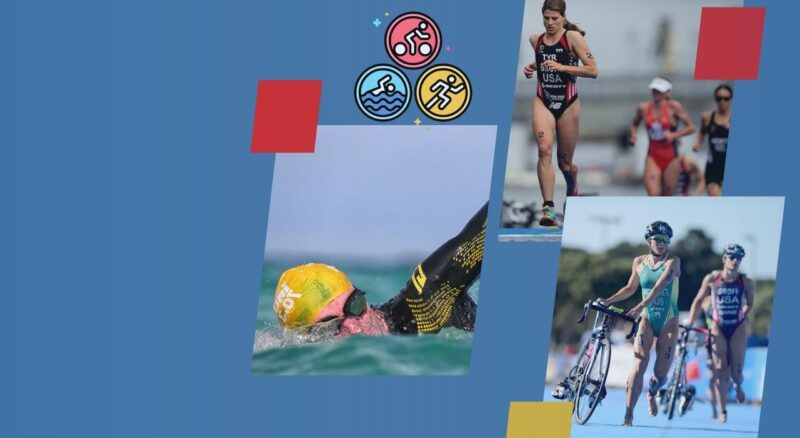So, you want to compete in a triathlon, huh? Well, let me tell you, it’s not just a race; it’s a journey. A journey filled with sweat, determination, and the thrill of crossing that finish line.
I remember my first triathlon like it was yesterday. The nervous energy, the excitement, the fear of the unknown. But guess what? I made it, and so can you. I challenge you to take this journey and I will help be your guide through it. Are you ready?
Pro Tip: Start with a sprint triathlon if you’re new to the sport. It’s a shorter distance and a great way to get your feet wet (literally and figuratively)
Understanding Olympic Triathlon
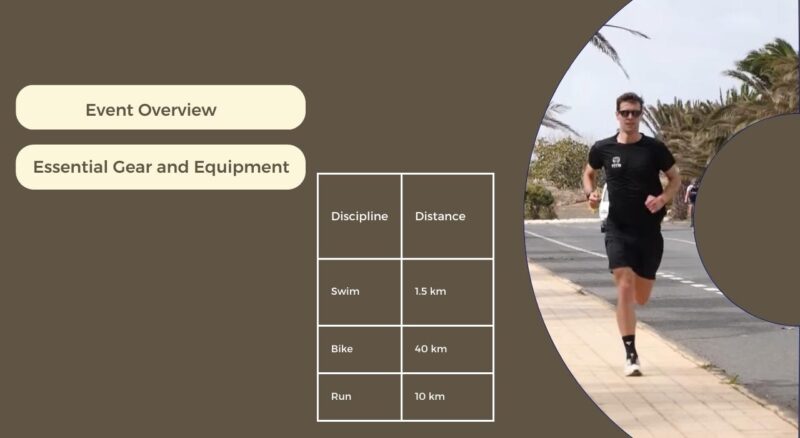
Event Overview
An Olympic Triathlon consists of three disciplines: swimming, biking, and running. Here’s a breakdown of the distances:
| Discipline | Distance |
| Swim | 1.5 km |
| Bike | 40 km |
| Run | 10 km |
The course challenges vary depending on the location and weather conditions. You might face choppy waters in the swim, hilly terrains in the bike ride, or scorching heat during the run. Being prepared for these variables is key to a successful race.
Essential Gear and Equipment
- Swim: Goggles, swimsuit (or wetsuit if allowed), and a swim cap.
- Bike: A road or triathlon-specific bike, helmet, cycling shoes, and sunglasses.
- Run: Running shoes, moisture-wicking clothing, and a hat or visor.
Fun Fact: Did you know that in some races, you can be penalized for not wearing a helmet during the bike portion? Safety first!
Setting Training Goals
Assessing Your Current Fitness Level
Before diving into training, it’s crucial to assess where you currently stand. Consider getting a fitness assessment from a professional or using online tools to gauge your baseline.
Setting Realistic and Measurable Goals
Set goals that are specific, measurable, achievable, relevant, and time-bound (SMART). Whether it’s completing the race or achieving a specific time, having clear goals will guide your training.
Training Periodization and Planning
Divide your training into different phases, focusing on endurance, strength, speed, and tapering. Here’s a simple table to illustrate the concept:
| Phase | Focus | Duration |
| Base | Endurance building | 8-12 weeks |
| Build | Strength & Speed | 6-8 weeks |
| Peak | Race-specific prep | 3-4 weeks |
| Taper | Rest & Recovery | 1-2 weeks |
Training periodization helps prevent burnout and ensures that you peak at the right time.
Swim Training Techniques
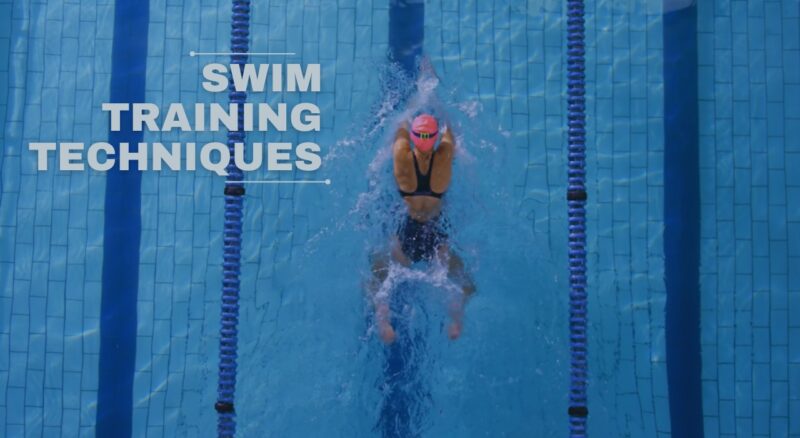
Developing Proper Swim Form
Proper form is essential for efficiency and conserving energy in the water. Focus on body alignment, a smooth stroke, and proper breathing techniques. Consider hiring a swim coach or joining a master’s swim group to get personalized feedback.
Pro Tip: Practice bilateral breathing (breathing on both sides) to maintain balance and adapt to varying conditions during the race
Building Endurance and Stamina
Start with shorter distances and gradually increase as your stamina improves. Mix in drills and interval training to build both endurance and speed.
Open Water vs. Pool Training
While pool training is excellent for working on technique and speed, open-water swimming is a different beast. Practice in open water to get used to sighting, navigating, and dealing with waves.
Fun Fact: Many triathletes find open water swimming to be the most challenging part of the race. The more you practice, the more comfortable you’ll become.
Bike Training Strategies
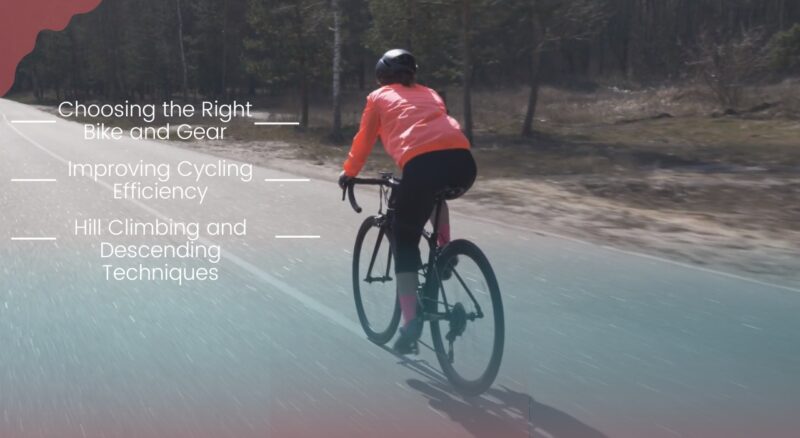
Choosing the Right Bike and Gear
Investing in a triathlon-specific bike can make a significant difference, but a good road bike can also do the job. Make sure it’s properly fitted to your body to avoid discomfort and injury.
Improving Cycling Efficiency
Work on your pedal stroke, body positioning, and gear shifting to ride more efficiently. Incorporate long rides, hill repeats, and interval sessions into your training.
Hill Climbing and Descending Techniques
Hills will be a real test of character in a race. Practice climbing with a steady, controlled effort, and work on your descending skills to gain confidence.
| Technique | Tips & Strategies |
| Hill Climbing | Maintain a steady cadence, use appropriate gears |
| Descending | Lean into turns, look ahead, apply brakes smoothly |
Run Training Styles
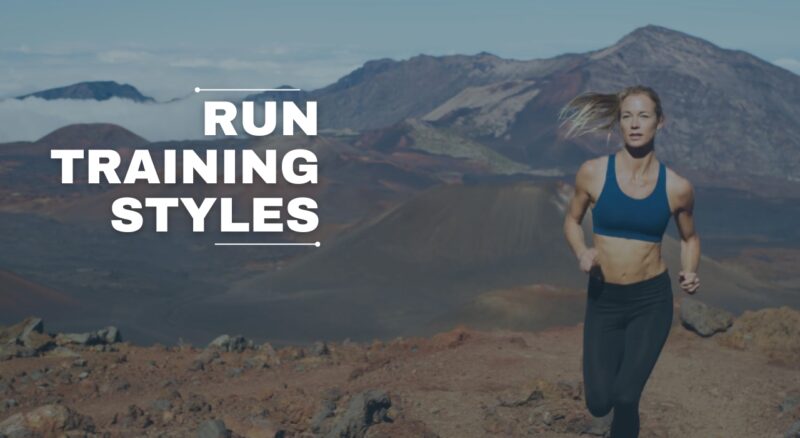
Building Running Endurance
Long, slow runs are the foundation of building endurance. These should be done at a comfortable pace, allowing you to build mileage without excessive strain.
Speed Work and Interval Training
Incorporate speed work and intervals to improve your pace. This can include track workouts, tempo runs, and fartlek training.
Transition Training: Swim to Run
Known as “brick” workouts, practicing the transition from swim to bike and bike to run is crucial. It helps your body adapt to the change in disciplines and can save valuable time on race day.
Pro Tip: After a bike training session, do a short run to simulate race conditions. It might feel strange at first, but it’s an essential part of your training
Incorporating Resistance Training
Importance of Strength and Conditioning
Strength and conditioning are often overlooked in triathlon training but are vital for improving performance and reducing the risk of injury. Incorporating resistance training helps in building power, improving stability, and enhancing overall athleticism.
Targeting Key Muscle Groups
Focus on exercises that target the muscle groups used in swimming, biking, and running. Here’s a simple table to guide you:
| Discipline | Key Muscle Groups |
| Swim | Shoulders, back, core |
| Bike | Quads, hamstrings, glutes |
| Run | Calves, glutes, hip flexors |
Injury Prevention and Recovery
Incorporate stretching, foam rolling, and mobility exercises to aid in recovery and prevent injuries. Consider working with a physical therapist or trainer to ensure proper technique.
Pro Tip: A well-rounded strength program should include functional movements like squats, deadlifts, and planks that mimic the demands of a triathlon.
Nutrition and Hydration

Fueling for Training Sessions
Your body needs the right fuel to perform its best. Focus on whole grains, fruits, vegetables, and legumes for sustained energy. Timing is also crucial; eat a balanced meal 2-3 hours before training and a small snack closer to the session if needed.
Pre-race Nutrition Strategies
In the days leading up to the race, continue to nourish your body with nutrient-dense foods. On race morning, opt for easily digestible carbohydrates and avoid anything new or unfamiliar.
Staying Hydrated During Training and Races
Hydration is key to performance. Drink water throughout the day and consider sports drinks during longer workouts to replace lost electrolytes.
Interesting Fact: Dehydration can significantly impact performance, even a 2% loss of body weight in fluids can lead to a noticeable decrease in ability
Mental Preparation and Race Strategy
Overcoming Pre-Race Nerves
It’s normal to feel nervous before a race. Focus on what you can control, trust your training, and develop a pre-race routine to calm your nerves.
Developing a Race Day Plan
Plan your race strategy, including pacing, nutrition, and how you’ll handle potential challenges. Visualize each stage of the race and how you’ll execute your plan.
Visualization and Positive Thinking
Mental rehearsal and positive thinking can enhance performance. Spend time visualizing success and use positive affirmations to boost confidence.
| Mental Technique | How to Apply |
| Visualization | Imagine yourself successfully completing each stage |
| Positive Affirmations | Repeat positive statements like “I am strong, I am prepared” |
FAQ
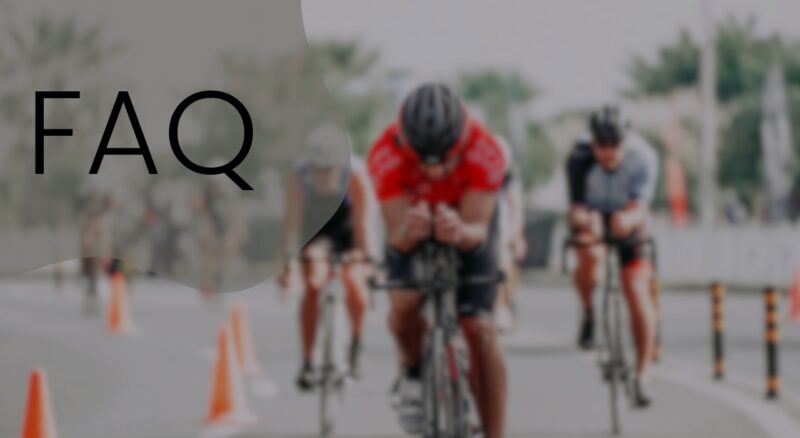
What’s the difference between Olympic and other triathlon distances?
Olympic triathlons are standardized at specific distances, while other triathlons like Sprint or Ironman vary in length.
How long does it take to train for an Olympic triathlon as a beginner?
Typically, 12 to 20 weeks, depending on your starting fitness level.
What are some common mistakes to avoid during training?
Overtraining, neglecting recovery, poor nutrition, and lack of race-day planning.
How do I prevent injury while training?
Follow a balanced training plan, include strength training, and listen to your body.
Can I use a wetsuit during the swim portion?
It depends on the race rules and water temperature. Check with the race organizers.
What if I can’t complete the full distances during training?
Focus on building up gradually and consider consulting a coach for personalized guidance.
How do I handle race-day nerves and anxiety?
Develop a pre-race routine, trust your training, and use visualization techniques.
Conclusion
Embarking on the journey to compete in an Olympic triathlon is both challenging and rewarding. With the right approach, dedication, and guidance provided in this guide, you’re well on your way to crossing that finish line.
Remember, it’s not just about race; it’s about discovering what you’re capable of. Embrace the journey, and happy training!

